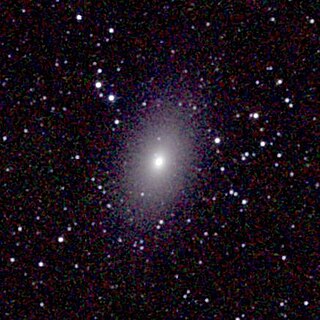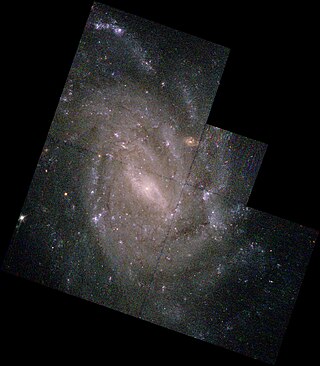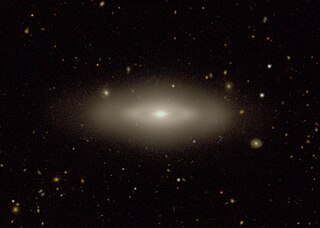
NGC 1512 is a barred spiral galaxy approximately 38 million light-years away from Earth in the constellation Horologium. The galaxy displays a double ring structure, with a (nuclear) ring around the galactic nucleus and an (inner) further out in the main disk. The galaxy hosts an extended UV disc with at least 200 clusters with recent star formation activity. NGC 1512 is a member of the Dorado Group.

The Atlas of Peculiar Galaxies is a catalog of peculiar galaxies produced by Halton Arp in 1966. A total of 338 galaxies are presented in the atlas, which was originally published in 1966 by the California Institute of Technology. The primary goal of the catalog was to present photographs of examples of the different kinds of peculiar structures found among galaxies.

NGC 5090 and NGC 5091 are a set of galaxies approximately 160 million light-years away in the constellation Centaurus. They are in the process of colliding and merging with some evidence of tidal disruption of NGC 5091.

NGC 4976 is a peculiar elliptical galaxy in the constellation Centaurus. It was detected with a 5" telescope working at 20x magnification by comet hunter Jack Bennett.

NGC 5101 is a lenticular galaxy in the constellation Hydra. It is separated in the sky from the spiral galaxy NGC 5078 by about 0.5 degrees, and both are believed to be at the same distance from the Earth. This would mean they are approximately 800,000 light-years apart. Both galaxies are believed to be about the size of the Milky Way.

NGC 5334 is a face-on barred spiral galaxy in the constellation Virgo. Its velocity with respect to the cosmic microwave background is 1668 ± 20 km/s, which corresponds to a Hubble distance of 80.2 ± 5.7 Mly (24.60 ± 1.75 Mpc). However, five non-redshift measurements give a distance of 108.68 ± 7.45 Mly (33.320 ± 2.283 Mpc). It was discovered by German-British astronomer William Herschel on 15 April 1787. It was also observed by American astronomer Lewis Swift on 20 April 1897 and listed in the Index Catalogue as IC 4338.

NGC 5986 is a globular cluster of stars in the southern constellation of Lupus, located at a distance of approximately 34 kilolight-years from the Sun. It was discovered by Scottish astronomer James Dunlop on May 10, 1826. John L. E. Dreyer described it as, "a remarkable object, a globular cluster, very bright, large, round, very gradually brighter middle, stars of 13th to 15th magnitude". Its prograde–retrograde orbit through the Milky Way galaxy is considered irregular and highly eccentric. It has a mean heliocentric radial velocity of +100 km/s. The galacto-centric distance is 17 kly (5.2 kpc), which puts it in the galaxy's inner halo.

NGC 1291, also known as NGC 1269, is a ring galaxy with an unusual inner bar and outer ring structure located about 33 million light-years away in the constellation Eridanus. It was discovered by James Dunlop in 1826 and subsequently entered into the New General Catalogue as NGC 1291 by Johan Ludvig Emil Dreyer. John Herschel then observed the same object in 1836 and entered it into the catalog as NGC 1269 without realizing that it was a duplicate. This galaxy was cited as an example of a "transitional galaxy" by NASA's Galaxy Evolution Explorer team in 2007.

Arp 271 is a pair of similarly sized interacting spiral galaxies, NGC 5426 and NGC 5427, in the constellation of Virgo. It is not certain whether the galaxies are going to eventually collide or not. They will continue interacting for tens of millions of years, creating new stars as a result of the mutual gravitational attraction between the galaxies, a pull seen in the bridge of stars already connecting the two. Located about 130 million light-years away, the Arp 271 pair is about 130,000 light-years across. It was originally discovered in 1785 by William Herschel. It is speculated, that the Milky Way will undergo a similar collision in about five billion years with the neighbouring Andromeda Galaxy, which is currently located about 2.6 million light-years away.

NGC 61 is a pair of lenticular galaxies, NGC 61-A and NGC 61-B in the constellation Cetus. Both were discovered on September 10, 1785, by William Herschel.

NGC 4790 is a barred spiral galaxy located in the constellation of Virgo. Its velocity with respect to the cosmic microwave background is 1679 ± 24 km/s, which corresponds to a Hubble distance of 80.8 ± 5.8 Mly (24.76 ± 1.77 Mpc). In addition, six non-redshift measurements give a distance of 74.75 ± 4.07 Mly (22.917 ± 1.249 Mpc). It was discovered on 25 March 1786 by German-British astronomer William Herschel.

NGC 6328 is an intermediate spiral galaxy located in the constellation Ara. It is classified as SAB(s)ab in the galaxy morphological classification scheme and was discovered by the British astronomer John Herschel on 2 May 1835. NGC 6328 is located at about 199 million light years away from Earth.

NGC 132 is a spiral galaxy in the constellation Cetus. Its velocity with respect to the cosmic microwave background is 5015 ± 25 km/s, which corresponds to a Hubble distance of 241.3 ± 16.9 Mly (73.97 ± 5.19 Mpc). In addition, three non redshift measurements give a distance of 250.81 ± 2.14 Mly (76.900 ± 0.656 Mpc). It was discovered on 25 December 1790 by German-British astronomer William Herschel.

NGC 148 is a lenticular galaxy located in the constellation Sculptor. It is about 40,000 light years across. It is in a group of three galaxies along with MCG-5-2-16 and IC 1555. It is a Shapley-Ames galaxy.

NGC 309 is a spiral galaxy in the constellation Cetus. Its velocity with respect to the cosmic microwave background is 5343 ± 22 km/s, which corresponds to a Hubble distance of 257.0 ± 18.0 Mly (78.81 ± 5.53 Mpc). However, nine non-redshift measurements give a much closer distance of 87.99 ± 10.45 Mly (26.978 ± 3.205 Mpc). It was discovered in 1876 by Wilhelm Tempel.

NGC 315 is an elliptical galaxy in the constellation Pisces. Its velocity with respect to the cosmic microwave background is 4635 ± 22 km/s, which corresponds to a Hubble distance of 223.0 ± 15.7 Mly (68.36 ± 4.80 Mpc). In addition, eight non-redshift measurements give a distance of 208.58 ± 22.28 Mly (63.950 ± 6.830 Mpc). It was discovered by German-British astronomer William Herschel on September 11, 1784.

NGC 338 is a spiral galaxy in the constellation Pisces. Its velocity with respect to the cosmic microwave background is 4479 ± 22 km/s, which corresponds to a Hubble distance of 215.5 ± 15.1 Mly (66.07 ± 4.64 Mpc). In addition, 22 non-redshift measurements give a distance of 223.56 ± 5.04 Mly (68.545 ± 1.544 Mpc). It was discovered in 1877 by Wilhelm Tempel. It was described by Dreyer as "very faint, very small, irregular figure, brighter middle."

NGC 473 is a lenticular galaxy in the constellation of Pisces. Its velocity with respect to the cosmic microwave background is 1819 ± 22 km/s, which corresponds to a Hubble distance of 87.5 ± 6.2 Mly (26.82 ± 1.91 Mpc). In addition, one non redshift measurement gives a distance of 97 Mly (29.8 Mpc). It was discovered on December 20, 1786 by William Herschel.

NGC 4694 is a lenticular galaxy in the constellation Virgo. Its velocity with respect to the cosmic microwave background is 1481 ± 23 km/s, which corresponds to a Hubble distance of 71.3 ± 5.1 Mly (21.85 ± 1.57 Mpc). However, six non redshift measurements give a distance of 28.51 ± 7.23 Mly (8.742 ± 2.218 Mpc). The galaxy was discovered by William Herschel on March 15, 1784.

NGC 997 is an interacting galaxy in the constellation of Cetus. The galaxy was discovered by Albert Marth on 10 November 1863. It has a regularly rotating central molecular gas disk, containing a black hole of between 4 x 107 and 1.8 x 109 solar masses. Its speed relative to the cosmological background is 6,270 ± 45 km/s, corresponding to a Hubble distance of 92.5 ± 6.5 Mpc (~302 million ly).




















